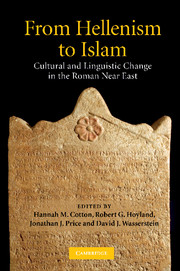Book contents
- Frontmatter
- Contents
- List of figures
- List of tables
- List of contributors
- Preface
- List of abbreviations
- Introduction: documentary evidence, social realities and the history of language
- Part I THE LANGUAGE OF POWER: LATIN IN THE ROMAN NEAR EAST
- Part II SOCIAL AND LEGAL INSTITUTIONS AS REFLECTED IN THE DOCUMENTARY EVIDENCE
- Part III THE EPIGRAPHIC LANGUAGE OF RELIGION
- Part IV LINGUISTIC METAMORPHOSES AND CONTINUITY OF CULTURES
- Part V GREEK INTO ARABIC
- 14 The Nabataean connection of the Benei Ḥezir
- 15 Greek inscriptions in transition from the Byzantine to the early Islamic period
- 16 Arab kings, Arab tribes and the beginnings of Arab historical memory in late Roman epigraphy
- 17 Greek, Coptic and the ‘language of the Hijra’: the rise and decline of the Coptic language in late antique and medieval Egypt
- 18 ‘What remains behind’: Hellenism and Romanitas in Christian Egypt after the Arab conquest
- Index
18 - ‘What remains behind’: Hellenism and Romanitas in Christian Egypt after the Arab conquest
Published online by Cambridge University Press: 01 March 2010
- Frontmatter
- Contents
- List of figures
- List of tables
- List of contributors
- Preface
- List of abbreviations
- Introduction: documentary evidence, social realities and the history of language
- Part I THE LANGUAGE OF POWER: LATIN IN THE ROMAN NEAR EAST
- Part II SOCIAL AND LEGAL INSTITUTIONS AS REFLECTED IN THE DOCUMENTARY EVIDENCE
- Part III THE EPIGRAPHIC LANGUAGE OF RELIGION
- Part IV LINGUISTIC METAMORPHOSES AND CONTINUITY OF CULTURES
- Part V GREEK INTO ARABIC
- 14 The Nabataean connection of the Benei Ḥezir
- 15 Greek inscriptions in transition from the Byzantine to the early Islamic period
- 16 Arab kings, Arab tribes and the beginnings of Arab historical memory in late Roman epigraphy
- 17 Greek, Coptic and the ‘language of the Hijra’: the rise and decline of the Coptic language in late antique and medieval Egypt
- 18 ‘What remains behind’: Hellenism and Romanitas in Christian Egypt after the Arab conquest
- Index
Summary
We will grieve not, rather find
Strength in what remains behind
William WordsworthWhen the Arabs conquered Egypt in 641, they found a deeply divided Christian church – in fact what they found amounted to two quite separate churches. They are usually called, in neutral terms, ‘Chalcedonian’ and ‘anti-’ or ‘non-Chalcedonian’, with reference to the Council of Chalcedon where their split had been consummated two centuries earlier. The two churches disagreed deeply on Christological questions, and during the two centuries that followed the Council, there were several, often heavy-handed, attempts to bring the non-Chalcedonian churches back into the imperial sphere. These events are unfortunately known mainly from polemical sources from both sides, and although this last fact does allow us to get a more balanced view, it also creates the impression that the Chalcedonian conflict dominated life in the Empire after the fifth century, an impression that certainly needs qualification.
In Egypt, the non-Chalcedonian or Monophysite church modelled itself on the highly centralised structure of the existing patriarchate of Alexandria, which, contrary to the other four patriarchates, did not have an intermediate level of metropoles between the patriarch and the local bishops. Both churches had their leaders in Alexandria, heading two welldeveloped parallel networks of episcopal sees and affiliated monasteries which covered most of the valley. In 641, the Chalcedonian church had, for over a century, been actively backed by the imperial power structure, often forcing the non-Chalcedonian hierarchy to leave the city centres and retreat to monasteries from where they managed their communities. The political break with Constantinople brought about by the Arab conquest eventually weakened the position of the Chalcedonian Church.
- Type
- Chapter
- Information
- From Hellenism to IslamCultural and Linguistic Change in the Roman Near East, pp. 447 - 466Publisher: Cambridge University PressPrint publication year: 2009
- 7
- Cited by

